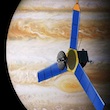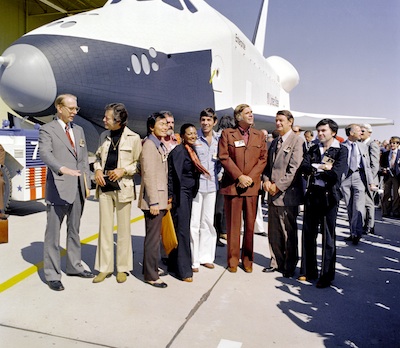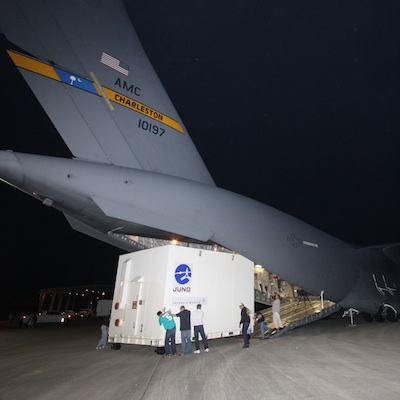 This week, witness the Navy’s newest laser weapon, visit the retiring space shuttles (and the Enterprise), prep for spacecraft Juno’s upcoming launch, and hear the first ever Earth-Space flute duet in honor of Yuri Gagarin, first man in space. All this and more plus your gadget of the week: NAVI (Navigational Aid for the Visually Impaired).
This week, witness the Navy’s newest laser weapon, visit the retiring space shuttles (and the Enterprise), prep for spacecraft Juno’s upcoming launch, and hear the first ever Earth-Space flute duet in honor of Yuri Gagarin, first man in space. All this and more plus your gadget of the week: NAVI (Navigational Aid for the Visually Impaired).
Navy Demos Powerful New Laser Weapon
Yes, you read that right. The US Navy has developed and is now testing a powerful new weaponized laser designed to blast enemy ships. In a test earlier this month, a futuristic laser mounted onto the deck of the Navy’s self defense test ship shot a small boat, causing it to catch fire. Some details of the event were classified, including the exact range of the shot, but Rear Adm. Nevin Carr told FoxNews.com, “We’re talking miles, not yards.” The Navy and Army are currently working to incorporate so called directed energy weapons into their standard arsenal. See the demo video below:
NASA Announces New Homes for Retiring Space Shuttles, Enterprise
NASA has announced where the four remaining space shuttles — three orbiters and one test vehicle, The Enterprise — will be stored upon retirement. The space shuttle Atlantis will be displayed at the Kennedy Space Center Visitor Complex in Florida; the Endeavor, at the California Science Center in Los Angeles; the Discovery, at the Smithsonian’s National Air and Space Museum Steven F. Udvar-Hazy Center in Virginia; and the test shuttle, Enterprise, at the Intrepid Sea, Air & Space Museum in New York. A sort of bidding war had been going on between 20 different sites, all seeking to house a space shuttle as a tourist draw. Only two shuttle flights remain: Endeavor on April 29 and Atlantis on June 28. After 30 years of launching satellites, building a space station, and launching and repairing an orbiting telescope, the shuttles become museum pieces.

Now you, too, can visit the Enterprise in New York
NASA’s Jupiter-bound Spacecraft Arrives in Florida
Juno, the soon-to-be Jupiter orbiter, set to launch this August, has arrived in Florida to begin final preparations for launch. The solar powered craft is designed to orbit Jupiter’s poles 33 times to study the gas giant’s origins, structure, atmosphere, and magnetosphere. Juno, conceived in 2003, is set to launch sometime between Aug. 5th, 2011 through Aug. 26th, 2011 and would arrive at Jupiter in July 2016 after a five year cruise.

Big box housing Juno unloaded in Fla.
Juno Mission Simulation
In other up-and-coming spacecraft news: parts of NASA’s James Webb Telescope, the next generation space telescope, began cryogenic testing.
First Ever Earth-Space Flute Duet
To honor the historic first human spaceflight of Yuri Gagarin, ISS astronaut performed the first ever Earth-Space flute duet. Coleman, an amateur flutist, and Anderson played a portion of the song “Bourree,” an arrangement of which Anderson and Jethro Tull performed during their 1969 U.S. tour as Neil Armstrong and Buzz Aldrin stepped on the moon. Coleman played her part from 220 miles above Earth late last week. Anderson played his part while on tour in Perm, Russia, during the weekend. The two parts were then joined.
Video of the Week: Possibly the most beautiful thing you’ll ever watch
The following video was created by Terje Sorgjerd at El Teide, Spain’s highest mountain (3715m). According to Sorgjerd, Teide is one of the best places in the world to photograph the stars. It’s also the location of Teide Observatories, one of the world’s best observatories. Watch and be in awe:
This is Funny, You Should Watch it of the Week: 31 Jokes for NERDS!
Hank of the vlogbrothers brings you 31 rapid-fire jokes for nerds. Why 31? Hank explains, “I chose 31 because I knew I wasn’t going to hit 50 and I wanted to do a prime number.”
Gadget of the Week: NAVI Navigational Aid for the Visually Impaired
NAVI, short for Navigational Aid for the Visually Impaired, is a student project to design and build a system that will augment the visually impaired person’s impression of a room. The device uses a Microsoft Kinect camera, a vibrotactile waist belt, a blutooth headset, and a specially designed lap-top carrying backpack to run special software. See the thing in action below.
This day in Science history
Replacing my previous #FollowFriday section, which is no longer timely after our permanent move to Science Saturday, is a list of fun facts for you about the famous scientists and science events linked with this day in history. On April 16th, these things happened:
- Born today:
- Joseph Black, discoverer of latent heat, specific heat, and CO2 (1728)
- Sir Hans Sloane, whose collection became the foundation of the British Museum. Also inventor of drinking chocolate milk. (1660)
- In 1976, deep-space probe Helios B made what was then the closest controlled approach to the sun at 27 million miles (43 million km, or 0.3 AU).
- In 1943, the hallucinogenic effects of LSD were first observed accidentally by Swiss chemist, Albert Hofmann.
Science Bytes
Not enough science for you? Here’s a warp-speed look at some more science tid-bits that are worth a peek.
- Hitchhiking into space on Russian Soyuz gets pricier
- Quantum leap: scientists teleport bits of light
- Researchers unlock key to keeping beer fresh longer

An earth-space flute duet, marking an anniversary of ….something….
Kinda dissapointed that the 50th anniversary of the FIRST MAN IN SPACE wasn’t much more then an afterthought here….
Space. The Final Frontier. Soon we will be going to other worlds. Also will be armed with Lasers and then Phase Cannons and then Phasers and Photon Torpedoes.
The El Teide-video is truly awe-inspiring.
NASA not choosing the home of Manned Space Flight Research at Johnson Space Center in Houston for a shuttle was a disgrace.
I can understand the shuttles going to the Smithsonian and Kennedy Space Center, but Los Angeles and New York over Houston? The astronauts all worked here, trained here and lived here, and now there’s going to be no tribute to the last 30 years of Manned Space Flight at the place where the vehicle was designed and managed from.
I can agree with you on this one, On the Spot. I heard the one of the reasons that Wright Patterson in Dayton didn’t get one was because of the accessibility of international tourist. And this is not a anti-New York or Los Angeles rant. Both are great American cities.
But you’re right about Houston’s place in American spaceflight. And yes, the world can get to Houston. This is one of those decisions that should have been made by looking at history and the greater benefit to the United States. New York and Los Angeles don’t need tourist dollars. The rest of us in-between need all the help we can get. Those tourist dollars would have certainly helped Houston.
Boy when the aliens attack, they’re in for a big surprise. We got lasers. :-) Hey, according to Hollywood, they’re coming. Skyline. Battle: Los Angeles. Cowboys and Aliens. (They’ve been here.) And Falling Skies. I keeed. I keeed.
Or maybe not….
http://en.wikipedia.org/wiki/Belgian_UFO_wave
The video at “El Teide” … is really wonderful … loved it!
:-) :-)
JFK is rolling over in his grave, we are now dependent on the Russians for manned travel to the Space Station. Way to go Obama!!! You’re the best!!!! NOT!!!
Juno is going to Jupiter, but unlike the Cassini mission, it carried nothing “extra” like Huygens… :-(
The science looks important, but geez, couldn’t they have tried to put a balloon probe into the atmosphere or something?
I miss the canceled JIMO (Jupiter Icy Moons Orbiter).
That was possibly the most beautiful thing I’ve ever watched. Thank you. :D
“Laser—it’s a little light bulb that blinks.”
“What’s with him?”
“Laser envy.”
:D
thats not a duet
yeah ill do my part now
you do yours later
well fix it in post
9
balloon probe?
you cant do that. that that thats science fiction ;)
11
LOL
4 and 5… By all accounts, Houston put together a very lackluster Space Shuttle Exhibit proposal, especially for the financing. Space Center Houston evidently was banking on NASA picking up a big chunk of the cost, and went into the competition with a sense of “entitlement”, that because it was Houston, they would get a Shuttle “just because”. Space Center Houston put together very little political support for Houston… their elected national officials (Hutchinson, Cornyn) and Governor (Perry) barely paid any attention until too late, and the local support was almost zero. There was almost as much press coverage of College Hills’ (Texas A&M’s) proposal to get a Shuttle as there was for Space Center Houston.
This has “fiasco” written all over it, and now that the deed is done, Texas it trying to win through legislation what it couldn’t through sound proposals, promotion and financing.
The Dayton, Ohio (National Museum of the USAF) proposal was awful. Absolutely awful. I suspect it didn’t get more than about five minutes consideration from NASA officials. Every other proposal for Shuttle exhibits had the Shuttles getting their own buildings, the centerpiece of a new “space wing” in a museum, or at least the “place of honor” in an existing space museum. The NMUSAF proposal was to stick a Shuttle down at one end of its new (fourth) hangar, hidden behind a Titan IV rocket and with a lowly old C-119 cargo plane looming over its shoulder.
NASA probably took one look and then said, “next!”.
What, no space shuttle for the Evergreen Aviation Museum up here in Oregon???? Heresy!!!
Anyways, the video by Terje Sorgjerd was indeed one of the most beautiful things I’ve ever seen, thanks for the share!
Witness the death of the American manned space program.
Cancelling Constellation as the shuttle’s replacement after it was actually tested is the dumbest move Obama ever made.
Purely political, BTW. (It was The Evil Bush’s program, so it MUST be bad!)
#8- Yeah, we’re dependent on Russia. How embarassing…
15… Reports of its death have been greatly exaggerated. The Bush plan was unaffordable: without a massive budget increase (which is simply politically impossible) NASA could have afforded either the Orion spacecraft of the Ares rockets to launch it, but not both. Worse, the Ares I rocket was shaping up to be more expensive and less powerful than planned. The Orion had already gone on major diets to accommodate the declining performance of Ares I (first its diameter shrank three feet, then it lost ground recovery and the money-saving re-usability that promised, and finally it was reduced from six crew to four). Ares V, the rocket needed to actually send Orion anywhere other than low Earth orbit, had grown into a behemoth even larger than Saturn V, requiring new engines and new tooling at Michoud to build it (read: expensive) and with a cost-per-flight estimated to be well north of $1 billion. The saddest thing is that outside observers predicted this almost exactly… in 2005. NASA brass stubbornly spent $9 billion trying to “make this dog hunt”, but in the end President Bush wasn’t even asking for money for it anymore and President Obama saw the price tag, said “enough is enough” and pulled the plug. Now Constellation’s pork supporters in Congress (almost entirely Florida and Alabama) are desperately trying to salvage parts of Constellation, with a new spacecraft called the Multipurpose Crew Vehicle which is still essentially Orion and a new rocket called the Space Launch System which looks more and more like Ares V with every new detail that is publicly released. We’ll probably spend another $5 billion on this train wreck before even the Florida and Alabama contingent can’t sell it to the rest of Congress anymore. And then, if there is anything left of NASA manned space by that point, we might, hopefully be able to buy astronaut rides on SpaceX’s Dragon or Boeing’s CST-100, cheap spacecraft (compared to Orion) riding on cheap rockets (compared to Ares I and V). That’s only if the taxpayers haven’t revolted against NASA spending $15 billion without producing any actual flight hardware and demanding major budget cuts, which is a distinct possibility.
Where’s Ian Anderson’s knighthood?
AND WHY ISN’T TULL IN THE ROCK ‘N’ ROLL HALL OF FAME??!
Urrgh
I’m a great supporter of Obama in general, but a bit displeased about Constellation’s cancellation. On the other hand, I am open to the possibility that Nasa’s current CCDev is going to yield something with long-standing potential. Right now, I’d put my money on Falcon 9 with the Dragon capsule.
The irony is, Republicans are advocating the pork-barrel laden, old-fashioned procurement path, while Obama is the one pushing for a diverse, competitive, market-driven mini-space-race.
Me, I’d be happy if the US putting in with the Europeans, Russia, and Japan, and forming a true United Earth Space Agency. Who knew the ideals of Star Trek might actually be applicable to the current state of affairs, with each country trying to one-up each other instead of working together? (Granted, the ISS is an example of this, but it’s the exception that proves the rule.)
^ last paragraph rewording:
Me, I’d be happy if the US put in with the Europeans, Russia, and Japan, forming a true United Earth Space Agency. Who knew the ideals of Star Trek might actually be applicable to the current state of affairs? Right now, each country trying to one-up each other instead of working together — granted, the ISS is an example of international cooperation, but it’s the exception that proves the rule.
The problem is the US would be funding the lion’s share of UESPA. NASA’s funding is greater than the rest of the world’s civil space funding combined.
Yay, here’s to the FL-1 (an old, Pre-TOS Laser, given gaming stats in FASA)!